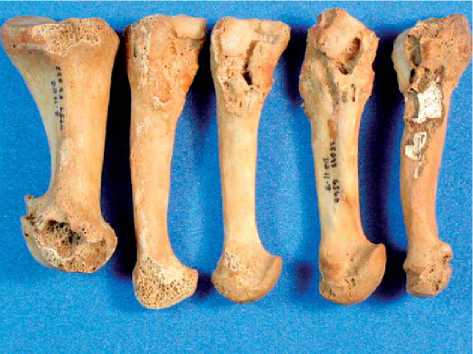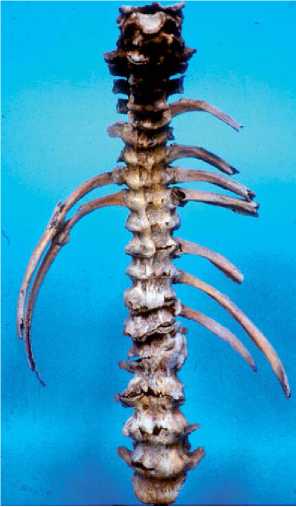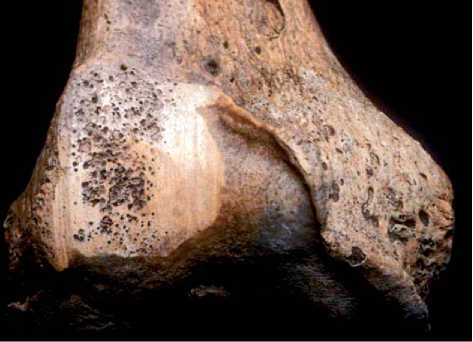Some conditions and diseases are related to overall advantageous socioeconomic status, prolonged longevity, and lifestyle/dietary factors. Both gout and DISH (diffuse idiopathic skeletal hyperostosis, hyperostotic or Forestier’s disease) are found in older individuals, normally males. The symmetrical (i. e., occurring in bilateral structures) erosive lesions of gout are caused by the deposition of urate crystals within and around joints, with the feet and frequently the first metatarsophalangeal joint often being affected (Figure 14). Its etiology is incompletely understood, but it appears to be associated with a fatty diet, rich in protein, and high alcohol intake, which in the past involved lead in the distillation process. Imbibed lead accumulated in the kidneys, causing renal failure, and the eventual accumulation of high levels of uric acid led to the formation of urate crystals. There may also be an hereditary component.
The etiology of DISH is unknown, although its occurrence in the remains of monastic populations and individuals buried in propitious locations in Medieval churches and churchyards would seem to

Figure 14 The erosive lesions of gout from a Carmelite friary, Medieval Lincoln, UK. These would have filled with urate crystals during life. Courtesy of the collections of the Biological Anthropology Research Centre (BARC), University of Bradford.
Suggest a dietary and/or lifestyle link. Overweight and adult onset diabetes mellitus accompanies DISH in some modern sufferers. Its skeletal manifestations are striking in advanced cases, with ossifications of tendinous and ligamentous entheses (producing enthesophytes) and ossification of the anterior longitudinal ligament on the right anterolateral side of the vertebral bodies (Figure 15) as well as at attachments for ligaments and muscles (i. e., extravertebral entheses). The left side of the vertebral column is thought to be spared due to the pulsation of the descending aorta with the passive hyperemia of the inferior vena cava contributing to bone formation on the right. Both gout and DISH are age-related conditions - that is, their occurrence increases with age. Thus, their prevalence, rather than indicating solely population ill health, also relates to increased age-at-death and a rich diet. These conditions appear to correlate with higher social status, among them cloistered ecclesiastics, aristocrats, and gentry in the past.
Osteoarthritis, an age-related degenerative joint condition, is perhaps one of the more perplexing conditions. Long linked to the physical behavior of individuals in the course of their daily activities, this association has been difficult to demonstrate from osteological studies, in part, perhaps, because those individuals who develop the condition from activity at a more youthful age retain the condition into old age when population prevalence rates increase as a whole. The relationship to activity has also been clouded by clinical evidence that some elite athletes, even when remaining highly active in their elderly years, do not have a higher prevalence of the disorder. A higher number of women than men are affected. It seems from recent studies that the predisposing factor

Figure 15 The ‘flowing candle-wax’ fusion of the anterior longitudinal ligament on the right anterolateral aspect of the vertebrae in DISH from Roman Droitwich, Worchestershire, UK. Photograph courtesy of Jean Brown from the collections of the Biological Anthropology Research Centre (BARC), University of Bradford.

Figure 16 Eburnation and porosity at the articulation of the patella with the femoral condyle when the lower limb is extended in a Medieval individual from Fishergate, York, UK. Photograph by the author, courtesy of York Archaeological Trust.
May be postural and weight related with consequent abnormal loading of the body’s joints, producing subchondral (i. e., in bone beneath the cartilage) micro-fracture, joint instability, and ossification of surrounding support structures. In the diarthrodial joints of the body, osteoarthritis is diagnosed on the presence of eburnation of parts of the articular surface and porosity that relate to the breakdown of cartilage (Figure 16). Joint space narrowing seen in clinical Cases is commensurate with joint surface contour change in bone specimens. Some researchers include para-articular (i. e., those that surround a joint) osteophytes as part of their diagnostic criteria, while others see para-articular osteophytosis as a separate condition and thus score it separately. The latter may be a response of soft tissue support structures to joint instability. Degeneration of the vertebral column, because it consists of fibrous joints (these cannot develop eburnation because they lack a synovium), is called ‘spondylosis deformans’.




 World History
World History









